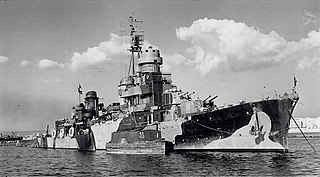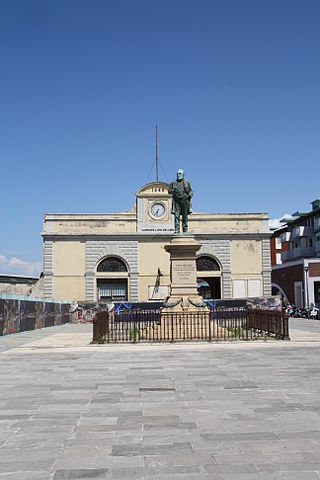
Giuseppe Garibaldi was an Italian aircraft carrier, the first through-deck aviation ship ever built for the Italian Navy, and the first Italian ship built to operate fixed-wing aircraft. Although she was widely recognised as a carrier first and foremost, she was officially designated as an aircraft-carrying cruiser. The ship was equipped with short take-off and vertical landing (STOVL) aircraft and helicopters. Giuseppe Garibaldi was involved in combat air operations off Somalia, Kosovo, Afghanistan and Libya.

The Italian Navy is one of the four branches of Italian Armed Forces and was formed in 1946 from what remained of the Regia Marina after World War II. As of August 2014, the Italian Navy had a strength of 30,923 active personnel, with approximately 184 vessels in service, including minor auxiliary vessels. It is considered a multiregional and a blue-water navy.

The Regia Marina (RM) or Royal Italian Navy was a navy of the Kingdom of Italy from 1861 to 1946. In 1946, with the birth of the Italian Republic, the Regia Marina changed its name to Marina Militare.

Bolzano was a unique heavy cruiser, sometimes considered to be a member of the Trento class, built for the Italian Regia Marina in the early 1930s, the last vessel of the type to be built by Italy. A modified version of the earlier Trento class, she had a heavier displacement, slightly shorter length, a newer model of 203 mm (8 in) gun, and a more powerful propulsion system, among other differences influenced by the Zara class that had followed the Trentos. Bolzano was built by the Gio. Ansaldo & C. between her keel laying in June 1930 and her commissioning in August 1933.

The Capitani Romani class was a class of light cruisers acting as flotilla leaders for the Regia Marina. They were built to outrun and outgun the large new French destroyers of the Le Fantasque and Mogador classes. Twelve hulls were ordered in late 1939, but only four were completed, just three of these before the Italian armistice in 1943. The ships were named after prominent ancient Romans.

Luigi Cadorna was an Italian Condottieri-class light cruiser, which served in the Regia Marina during World War II; named after Italian Field Marshal Luigi Cadorna who was commander in Chief of the Italian Army during World War I.

The Italian auxiliary cruiser Ramb III was built at Genoa by Ansaldo in 1938.

The Italian auxiliary cruiser Ramb II was a pre-war banana boat built at Monfalcone by the CRDA in 1937. She briefly served as an auxiliary cruiser with Regia Marina early in World War II before becoming an auxiliary transport with the Imperial Japanese Navy later in her career.

Console Generale Liuzzi was an Italian Liuzzi-class ocean-going submarine of the Regia Marina, launched in 1939 and sunk in 1940 by Royal Navy destroyers. It was named after Alberto Liuzzi (1898–1937), a console generale of the Blackshirts.

Giuseppe Garibaldi was an Italian Duca degli Abruzzi-class light cruiser, that served in the Regia Marina during World War II. After the war she was retained by the Marina Militare and upgraded. She was built by CRDA, in Stabilimento Tecnico Triestino shipyard Trieste and named after the Italian general Giuseppe Garibaldi.
Sparviero was an Italian aircraft carrier designed and built during World War II of the Regia Marina. She was originally the ocean liner MS Augustus built in 1926 for Navigazione Generale Italiana, but was transferred to the new Italian Line after the merger of Navigazione Generale Italiana with the Lloyd Sabaudo and the Cosulich Line. The conversion was started in 1942 originally under the name Falco but was never completed, and the ship was never delivered to the Regia Marina. She began to be scrapped in 1947, a process completed by 1951.

The Acciaio-class submarine was the fifth subclass of the 600 Series of coastal submarines built by the Regia Marina. They were completed during the early 1940s and saw service in World War II.
Pietro Micca was an Italian submarine which served with the Regia Marina in World War II. She was the third ship named after Pietro Micca, the Savoyard soldier who became a national hero for his sacrifice in the defence of Turin against the French troops in 1706. This boat was the prototype for a class of fast, long range submarines with conventional torpedo armament, naval mine laying capability, and useful secret transport capacity. The ship was built at the Tosi shipyard in Taranto. She was laid down on 15 October 1931 and launched on 31 March 1935. The boat fully met design requirements, but was too expensive to be repeated.

The Liuzzi class was a class of four submarines built by Tosi in Taranto for the Royal Italian Navy. The submarines were built in 1939 and began their Second World War service in the Mediterranean Sea, where Liuzzi was sunk. The three surviving boats were transferred to the BETASOM Atlantic submarine base at Bordeaux in 1940. After Tarantini was sunk, Bagnolini and Giuliani were selected for conversion to "transport submarines" in order to exchange rare or irreplaceable trade goods with Japan. Cargo capacity of 160 tons reduced reserve buoyancy from between 20 and 25% to between 3.5 and 6%; and armament was reduced to defensive machine guns. The submarines saw action in the Second World War during which they collectively sunk 5 freighters and 1 light cruiser and were eventually either sunk or captured.

Cantiere navale fratelli Orlando is a historical Italian shipyard in Livorno.
Evangelista Torricelli was one of four Archimede-class submarines built for the Regia Marina during the 1930s. She served in the Spanish Civil War of 1936–1939, and was transferred to the Armada Española of Nationalists in 1937, renamed as General Mola.
Goffredo Mameli was the lead ship of her class of four submarines built for the Regia Marina during the 1920s.

Scipione Africano was an Italian Capitani Romani-class light cruiser, which served in the Regia Marina during World War II. As she commissioned in the spring of 1943, the majority of her service took place on the side of the Allies - 146 wartime missions after the Armistice of Cassibile versus 15 before. She remained commissioned in the Italian navy after the war, until allocated to France as war reparations by the Paris Peace Treaties of 1947. Scipione Africano was decommissioned from the Marina Militare in August 1948 and subsequently commissioned into the Marine Nationale as Guichen, after briefly being known as S.7.
Nicola Fabrizi was an Italian La Masa-class destroyer. Commissioned into service in the Italian Regia Marina in 1918, she served in the final months of World War I, participating in the Adriatic campaign. She was reclassified as a torpedo boat in 1929. After Fascist Italy entered World War II, she served mainly in the Adriatic campaign as a convoy escort in the Adriatic Sea, taking part in the Action in the Strait of Otranto in 1940. She also served in the Mediterranean campaign. After the fall of Fascist Italy and the Italian armistice with the Allies in 1943, she switched to the Allied side and operated as a unit of the Italian Co-belligerent Navy until 1945. A part of the Italian Navy after the Italian Republic replaced the Kingdom of Italy in 1946, she remained in service during the Cold War and was reclassified as a minesweeper in 1953. Stricken in 1957, she subsequently was scrapped.
Barletta was an Italian cargo liner built during the 1930s and later became an auxiliary cruiser of the Regia Marina during World War II.











